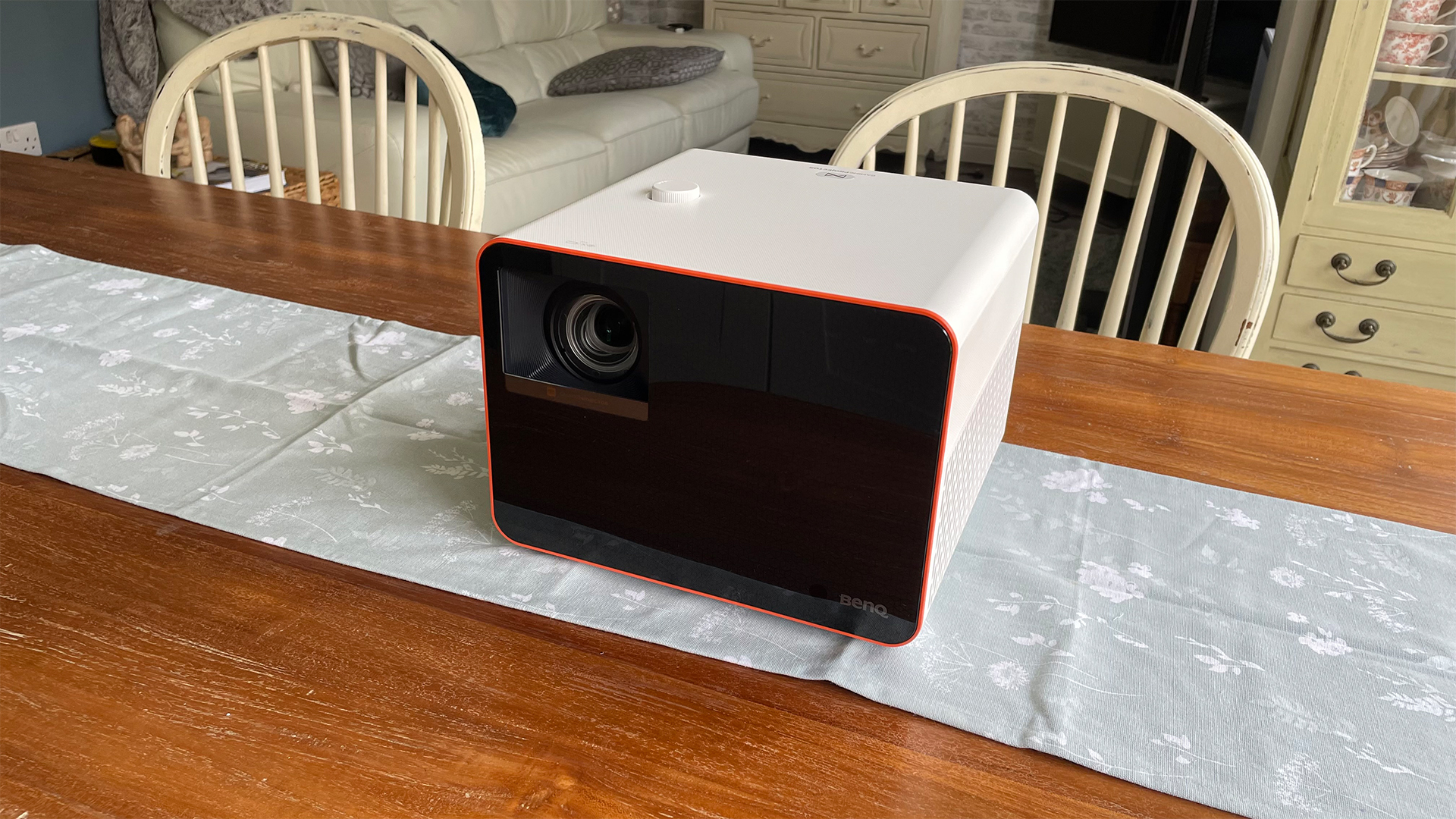
Despite costing pretty serious money for what’s ostensibly a fairly casual projector, the BenQ X3100i looks at first glance to be all about having fun. Its cubic design is cuter and cooler than that of most home entertainment projectors, and BenQ is keen to stress that this is a projector designed very much with gaming in mind. It even has the words ‘gaming projector’ written on its top edge, in fact.
The more time we spend with the X3100i, however, the more convinced we are that its hip looks and strong gaming chops are actually just the start of its charms.
Price
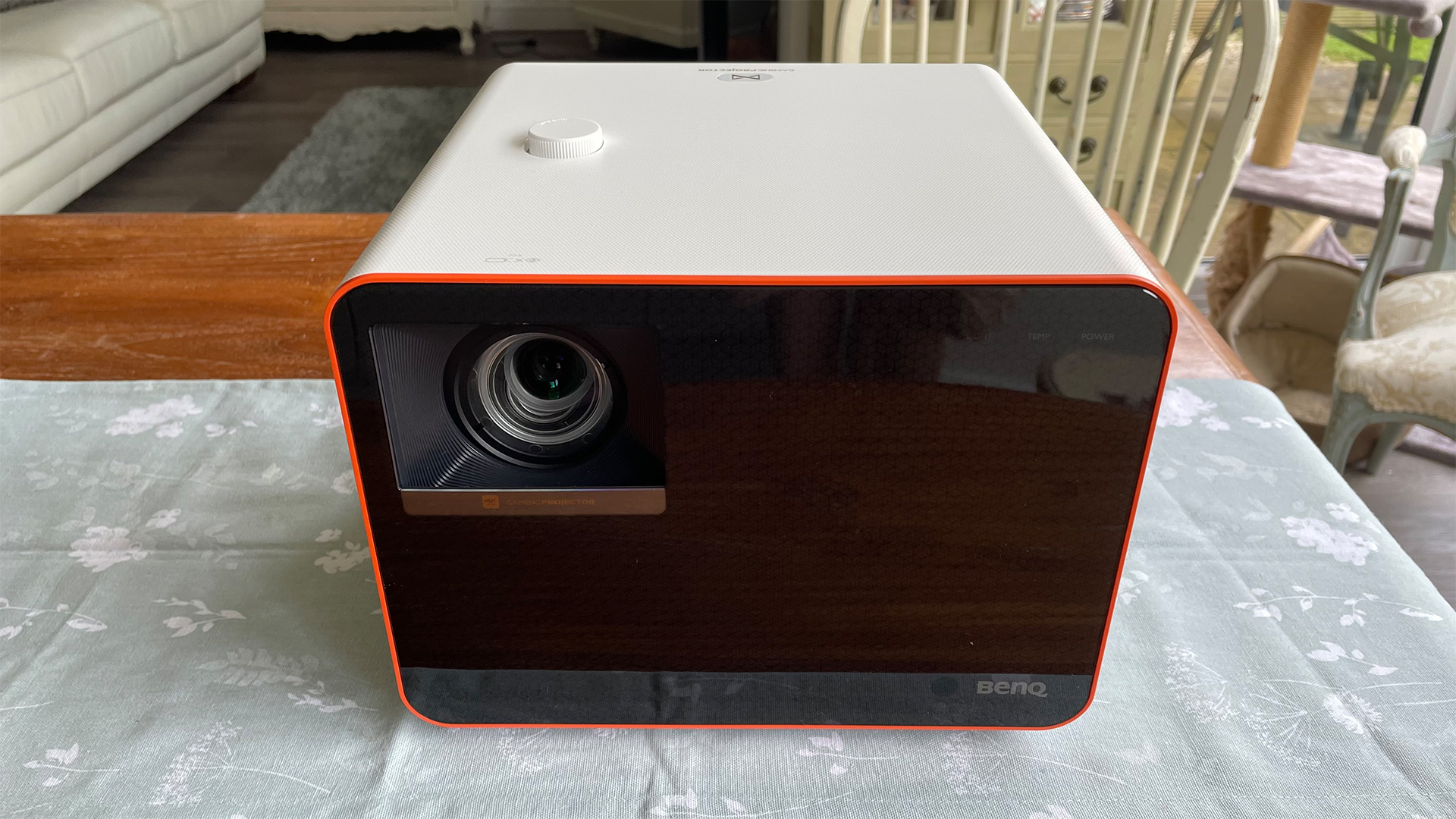
By gaming projector standards, the X3100i’s £2099 / $2399 / AUS$3599 asking price represents quite a chunk of change. It is, though, BenQ’s current flagship gaming projector – and as we’ll see, it delivers on that flagship status well enough to actually make the price seem far from unreasonable to anyone who a) takes gaming seriously and b) has a good quality gaming source to take advantage of its abilities. And that’s before we even mention that it’s also highly capable of adapting to movie viewing when you’re not in a gaming mood.
The X3100i goes the extra mile to try and justify its price, too, by including an unusually potent built-in speaker design (that partly explains the quirky cubic shape), and an integrated Android TV smart system.
Design

Like all of BenQ’s X series of gaming projectors, the X3100i enjoys a more striking, cutesy design than typical home entertainment projectors are treated to.
It stands way taller for starters – in fact, it’s almost as tall as it is wide. Its top and sides are finished in a crisp, living room-friendly white, while its front edge enjoys a starkly contrasting glassy black finish with an orange trim running around its outer edges. The projector’s edges and corners are neatly rounded off to soften what might otherwise have been a rather ‘sharp’ appearance, too, and the bottom half of each side features a grilled finish to both help the projector expel heat from its LED lighting system and emit sound from an unusually powerful built-in sound system by projector standards.
The promisingly large recessed lens sits in the top left corner of the black fascia, while the top edge holds a simple wheel-style vertical image shifter. The left side contains a ‘window’ cut into it where you can access zoom and focus adjustments wrapped around the lens barrel, as well as a pretty fulsome selection of on-unit control buttons.
The top edge of the projector can be removed to gain access to a hidden HDMI bay where you can tuck BenQ’s Android TV streaming dongle. As well as being tidy, this hidden bay means you don’t need to take up one of the projector’s visible HDMI connections with the Android adaptor.
The X3100i ships with a projector-focused remote of its own and a smart remote associated with the Android TV dongle. The latter handset includes a handy selection of four direct video streaming app buttons for Netflix, Prime Video, YouTube and Disney+.
Features
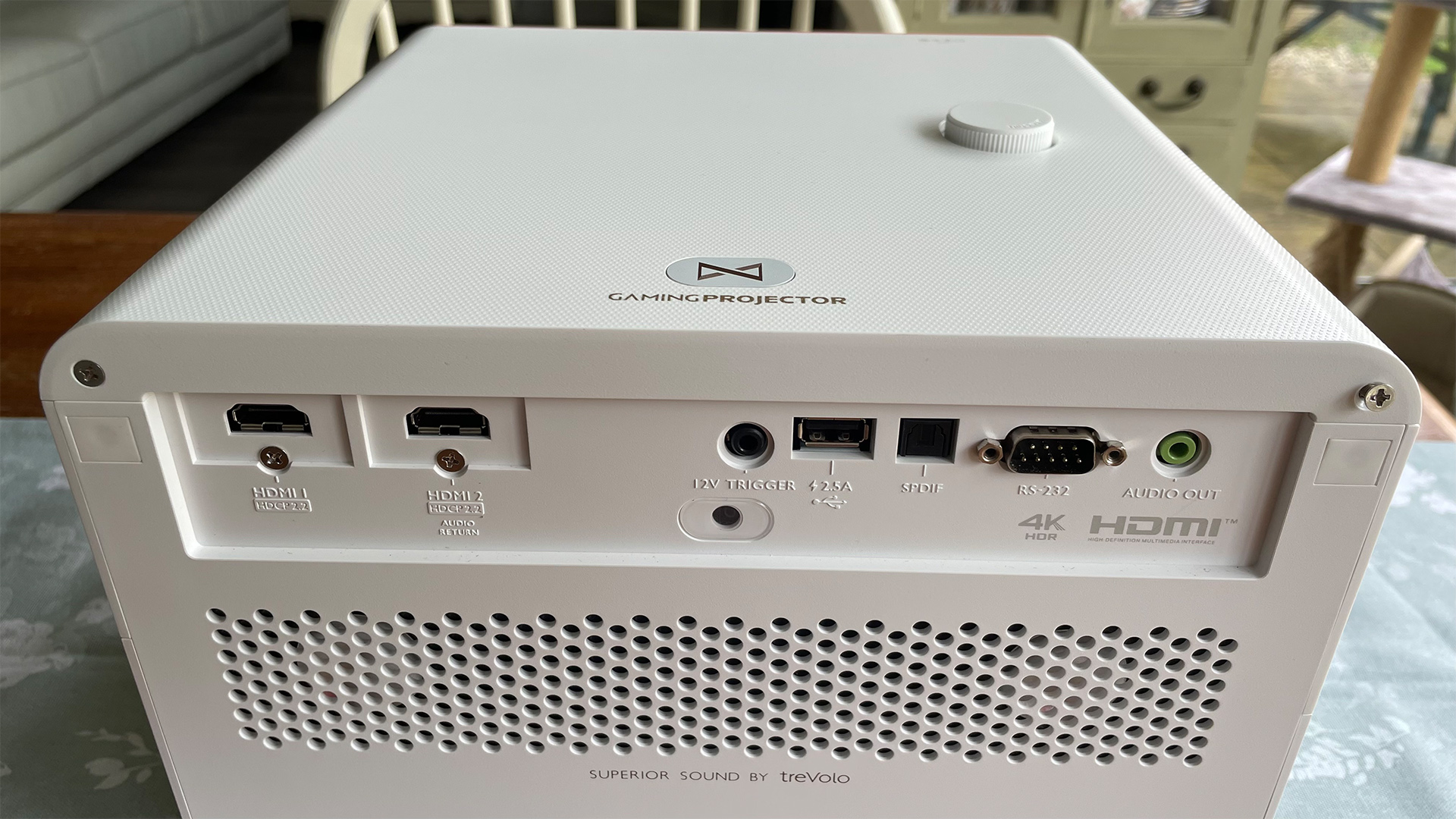
The BenQ X3100i is a DLP projector illuminated by a 4LED lighting system. This adds a so-called extra ‘pump’ LED to the usual red, green and blue LEDs that extends the projector’s life span (to a claimed 30,000 hours before lamps should need changing), enables the X3100i to retain a relatively small footprint by projector standards, and amplifies the overall output of green light to enhance brightness. BenQ claims the X3100i is 12 per cent brighter than a regular 3LED set-up, in fact.
The X3100i claims to be a 4K projector, too, courtesy of DLP’s XPR technology, where the switchable mirrors on the DLP chipset are ‘flashed’ multiple times per image frame to create a (Consumer Technology Association-approved) 4K effect.
High dynamic range playback is supported in the HDR10 and HLG formats and backed up by HDR tone mapping and a proprietary-to-BenQ ‘SSI’ Dynamic Black automatic light management technology that’s claimed to deliver a very high contrast ratio of 600,000:1.
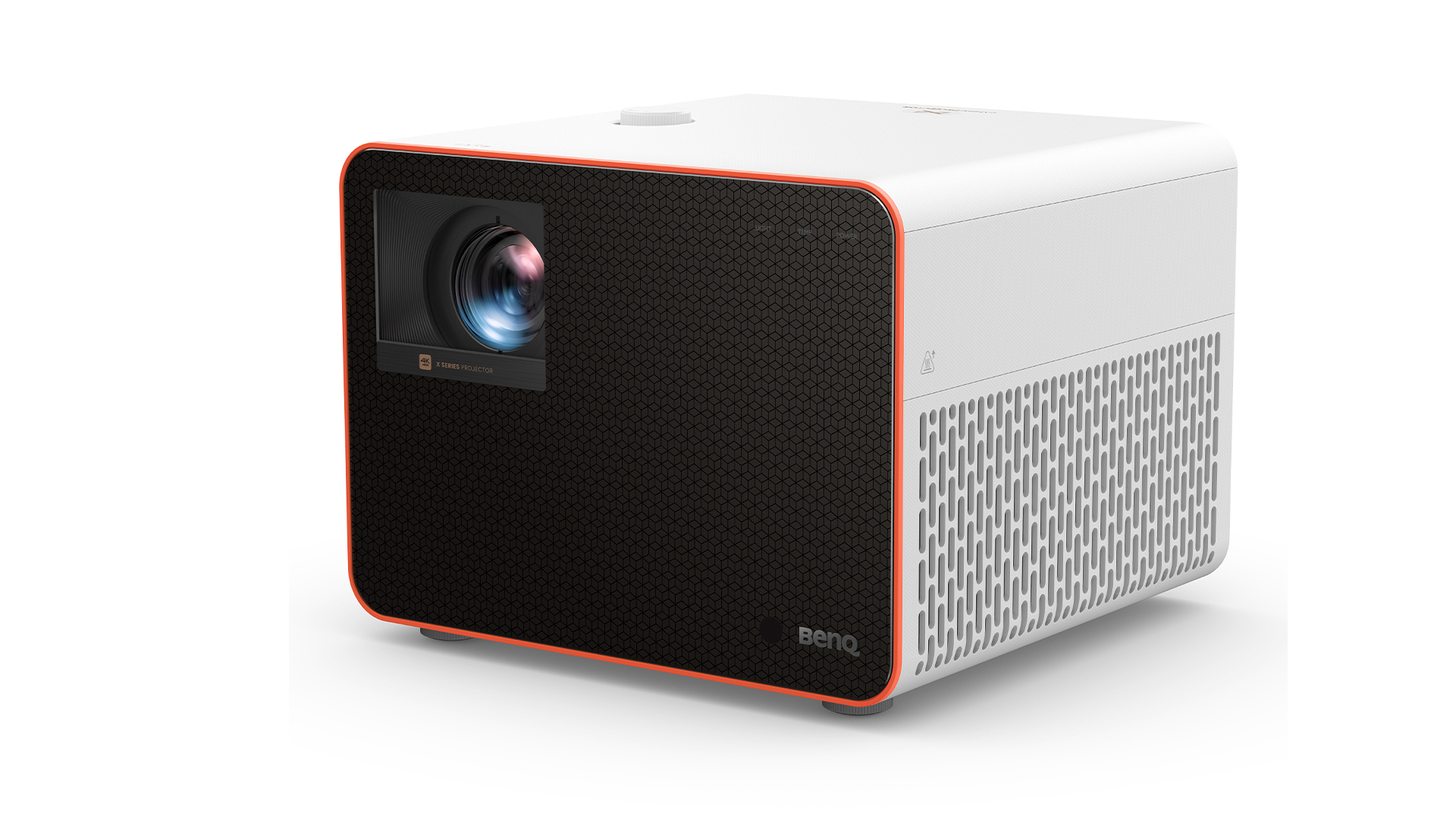
Projector type 4LED DLP
Processing DynamicBlack, motion processing, light source dimming, HDR tone mapping
Screen size Up to 200in (claimed)
Native resolution 3840x2160 (via DLP XPR pixel shifting)
Input lag with 60Hz in fast response mode 9ms
HDR support HDR10, HLG
Dimensions 21 x 27 x 26 cm
The X3100i continues to push some impressive on-paper numbers with its colour performance, which is claimed to cover the full 100 per cent of the DCI-P3 range commonly used with HDR video. The 4LED lighting system appears to make a difference here again, with BenQ claiming this light system can produce 20 per cent ‘bolder’ colours than regular lamp projectors.
The gaming credentials the X3100i builds so much of its identity on are genuinely extensive. Its input lag, for starters, drops to just over 4ms with 120Hz feeds – a remarkably low figure for anything outside the dedicated gaming monitor world. BenQ has also thoughtfully provided four specialist game presets that adjust both the projector’s picture and sound to suit different gaming genres.
The X3100i’s HDMI 2.0b connections support 4K at 60Hz and 1080p at 120Hz – though Xbox Series X owners should note that, oddly, while 4K@60Hz works in tandem with HDR, the HDR isn’t sustained if you switch to 1080p@120Hz. The X3100i also supports ALLM switching and eARC so that you can pass 7.1 and even lossless Dolby Atmos game (or movie) soundtracks through the projector to a connected soundbar or AV receiver.
A digital zoom feature even allows you to shrink the image down if you want to take all the action in more easily during competitive FPS sessions. Though while this sounds a great feature on paper, the edge is taken off by the fact that using the digital zoom can increase input lag…
The X3100i also provides the option to call up a crosshair in the centre of the screen, but perhaps the single most innovative gaming feature of the X3100i is the SettingXchange. This is a facility for downloading expert projector image settings created by celebrity gamers for certain top games so that you can essentially enjoy exactly the same visual experience those pros did. Though of course, if you still suck after engaging one of these downloaded set-up profiles, you officially have nothing to blame but yourself.
The X3100i is both impressively flexible and easy to set up. A 1.3x optical zoom gives you some leeway over how far from your wall or (ideally) screen you place it, while the vertical image shifting wheel on the top edge lets you move the image up or down to reduce the chances of you having to use image distorting keystone correction to keep the edges of the image parallel. The lens adjustments aren’t motorised but they are responsive, tightly calibrated and easily accessed.
The audio system built into the X3100i is a stereo 5W affair, which doesn’t sound an awful lot on paper. As we noted in the Design section, though, the projector’s distinctive cubic shape gives the sound more ‘room for manoeuvre’ than most projectors can support. Also, crucially for its gaming ambitions, the X3100i’s sound is powered by CinematicSound technology, where a ‘Bongiovi DPS’ audio processor tries to create a three-dimensional surround sound effect with accurately placed effects from the simple two-speaker set up.
Last and kind of least on the X3100i’s feature list are its smart features. Provided by the BenQ wireless ‘stick’ tucked in the hidden HDMI bay on the projector’s top edge, they’re built on the Android TV platform. Which as usual with projectors proves a bit of a mess. We have experienced numerous bugs and crashes, and the app support is hit and miss. So while Netflix, YouTube, Google Play Movies and TV, Prime Video and Disney+ are all present and correct and deliver images optimised to the projector’s capabilities, there is currently no sign of the BBC iPlayer, All 4 or My5 catch-up apps. Also, while the ITVX app appears on the home screen, trying to open it causes a ‘not available for this product’ message.
With Hisense and Samsung in particular managing to implement smart systems on their projectors that are essentially as stable and content-packed as the ones they provide on their TVs, the sort of smart TV frustrations delivered by the X3100i are becoming harder to tolerate.
Picture
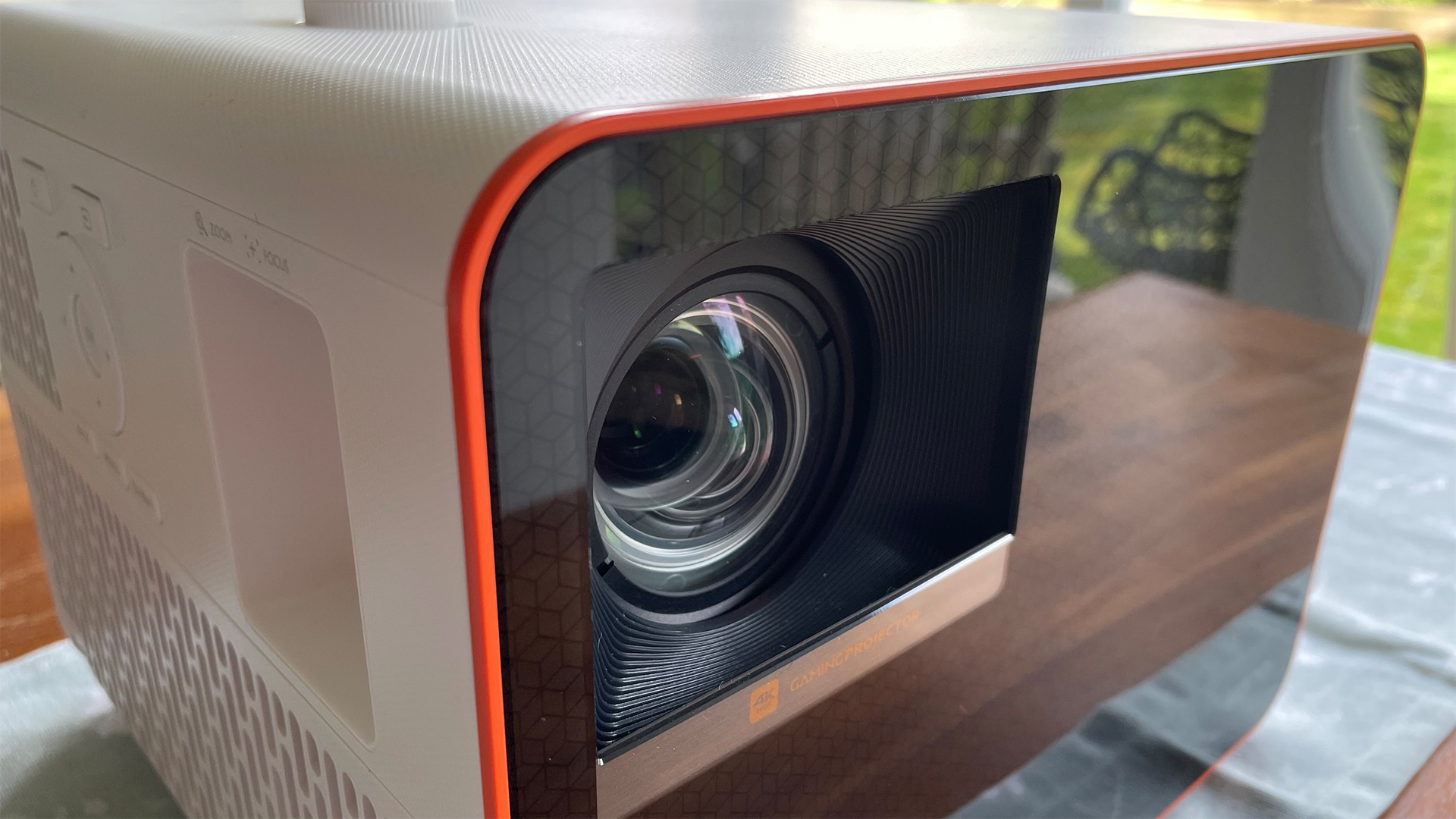
Meanies that we are, we kick our tests of the X3100i’s picture quality off not with the game sources it was literally made for, but with a selection of our favourite 4K Blu-ray test movies. Happily, though, this doesn’t phase the X3100i at all. In fact, it does a better job with all of our movie choices than many supposedly more film- or home entertainment-focused models we’ve tested recently.
Particularly great to see after seeing so many recent failures in this department is how well the X3100i handles the extremes of brightness and darkness associated with HDR content. HDR is not – and never will be, given it was created for the very different mechanics of TV screens – an easy thing for projectors to deliver. The X3100i’s 3300 lumens of peak brightness, though, deliver bright HDR scenes with more than enough intensity to sell the HDR experience. At the same time though, its various image analysis and brightness control features – especially Dynamic Black – do a remarkably effective job of reining the 4LED lighting in to produce much more convincing and consistent black levels than so many of its brightness-obsessed peers manage.
The constant adjustments the X3100i makes to brightness in its most effective HDR playback set up are somehow delivered, too, without the sort of obvious instability and hyperactive brightness shifts we might have expected from a projector that works so hard to achieve good results with even quite extreme light and dark imagery.
The result is a picture that remains consistently natural looking during both bright and dark scenes – and where there’s consistency, there’s immersion. And where there’s immersion, there’s a much greater level of connection with and enjoyment of what you’re watching. Especially at the sort of image scale the X3100i is capable of delivering.
The X3100i’s colour performance is a cut above most of the competition, too. Exceptionally vibrant animated content such as Puss In Boots: The Last Wish on 4K Blu-ray erupts off the screen with some of the most dazzlingly rich saturations we’ve seen around this price point. At the same time, though, there’s seldom if ever anything uncontrolled or unbalanced about even the X3100i’s boldest tones.
Maybe even more impressive, though, is how natural the X3100i’s colours look with relatively subtle imagery, such as skin tones and dark clothing colours in low-lit scenes. The results are, again, consistently authentic, and aren’t affected by fizzing or compression blocking noise, or any major signs of striping interference over subtle blends. On the contrary; the X3100i’s colours are rendered with so much subtlety that images enjoy a sense of three-dimensionality, sharpness and detail that makes the X3100i’s 4K resolution claims seriously easy to believe. In fact, even HD sources look 4K after passing through the X3100i’s optics.
Motion looks credible and natural, too, even with 24p movie sources – and without any need to apply any motion processing.
All this picture goodness is being achieved, don’t forget, with films, not the game sources this BenQ projector is supposed to excel with. It doesn’t come as too much of a shock, then, that the X3100i continues to excel, with knobs on, when fed the likes of Call Of Duty, FIFA, and Diablo IV from your gaming device of choice. The brightness, sharpness, colour saturation and consistently effective contrast intersect immaculately with every game genre and location.
The X3100i delivers one of the most responsive gaming experiences we’ve had outside of a dedicated gaming monitor, too. This is especially true at 120Hz; so much so that we’d strongly recommend that you sacrifice 4K resolution for the extra immediacy of the higher frame rate.
This statement does make us wish – perhaps a bit unrealistically given the X3100i’s price – that it could deliver 4K at 120Hz. And with that we should turn our thoughts to a few other limitations of the X3100i’s picture efforts.
So, for starters, while black levels are generally good with HDR content, things can occasionally turn a bit grey under extreme circumstances – such as when a mostly very dark shot is punctured by a particularly bright object, such as a streetlight or full moon. You can improve this if it’s happening a lot in a particularly contrast-rich film by nudging down the level of a provided HDR Brightness adjustment – but doing this also removes a bit of shadow detail.
We are also occasionally aware of a little of DLP’s rainbow effect, where stand-out bright objects can cause you to see stripes of red, green and blue flitting in your peripheral vision.
Ultimately, though, there’s nothing wrong with the X3100i’s pictures that’s severe enough or occurs often enough to stop it from being a star performer for film lovers and gamers alike.
Sound

The X3100i sounds much better than most projectors do. In the Cinema mode, for instance, aspects of a surround sound game or movie mix are cast a surprising distance from the projector’s bodywork – enough, genuinely, to make you feel part of the audio world provided you’re not sat too far from where the projector is placed.
The dynamic range is impressive, too, with crisp but never shrill trebles at one end of the spectrum, and deeper bass than most projectors manage at the other. The midrange between the extremes is well-rounded and clean, too, and dialogue tends to remain clear at all times without losing its sense of context.
The speakers appear to know their limitations, too, meaning they avoid the sort of distortions you get with speakers that try too hard.
The only issues are that it doesn’t get loud enough to match the scale of the X3100i’s pictures, and that while some sound effects are propelled far and wide, the main midrange can feel a little trapped within the projector’s bodywork. This can mean the audio doesn’t sound like it belongs with the distant pictures on the screen unless you manage to sit in just the right ‘hot spot’.
To be fair, though, the sound quality of most projectors isn’t good enough to warrant more than a dismissive line or two, so the fact that there’s enough going on with the X3100i’s sound to bother picking out a specific fault with it is arguably actually a strength by projector standards.
Verdict

While BenQ’s X3100i lives up to its flagship gaming projector billing by delivering a fantastically responsive, immersive, vibrant and sharp experience, it also works surprisingly brilliantly with movies. Add in a more than serviceable built-in sound performance, too, and the X3100i’s initially intimidating price actually starts to look like a bargain.
Review published: May 2023. Review updated: November 2024.
SCORES
- Picture 5
- Sound 4
- Features 4
MORE:
Read our review of the Xgimi Horizon Ultra
Also consider the Optoma UHZ66
Read our Epson LS650







